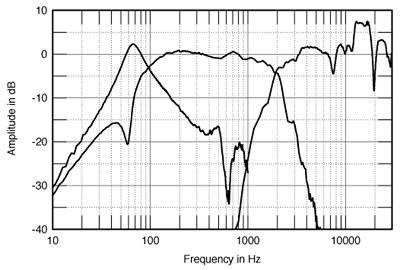| Columns Retired Columns & Blogs |
KEF RDM Two loudspeaker Measurements
Sidebar 3: Measurements
Although the little KEF's impedance (fig.1) can be seen to drop to 5 ohms and below in the lower midrange and at ultrasonic frequencies, it is, overall, an easy load for an amplifier to drive. The large peak just above 2kHz is due to the crossover; the twin peaks in the bass are due to the reflex alignment. The tuning of the port is given by the frequency of the "saddle" between the low-frequency peaks: 63Hz, which implies only moderate bass extension. On the other hand, the RDM Two will play loud with only a few amplifier watts—I estimated its B-weighted sensitivity as almost reaching the specified 90dB/2.83V/m, which is well above average. For home-theater use, its combination of benign impedance and high sensitivity means that the RDM Two will work well even with underpowered A/V receivers.
Although the little KEF's impedance (fig.1) can be seen to drop to 5 ohms and below in the lower midrange and at ultrasonic frequencies, it is, overall, an easy load for an amplifier to drive. The large peak just above 2kHz is due to the crossover; the twin peaks in the bass are due to the reflex alignment. The tuning of the port is given by the frequency of the "saddle" between the low-frequency peaks: 63Hz, which implies only moderate bass extension. On the other hand, the RDM Two will play loud with only a few amplifier watts—I estimated its B-weighted sensitivity as almost reaching the specified 90dB/2.83V/m, which is well above average. For home-theater use, its combination of benign impedance and high sensitivity means that the RDM Two will work well even with underpowered A/V receivers.

Fig.1 KEF RDM Two, electrical impedance (solid) and phase (dashed) (2 ohms/vertical div.).
Fig.2 reveals that the acoustic crossover between the coaxial drive-units is set at 2kHz, with very steep slopes, implying the use of 4th-order filters. The top octave is boosted by around 6dB exactly on-axis, presumably due to the acoustic loading offered to the tweeter dome by the woofer cone. In the bass, the maximum port output occurs between 60Hz and 70Hz, as implied by the impedance trace, and looks a little underdamped. The port output is free from higher-frequency resonant problems, however.

Fig.2 KEF RDM Two acoustic crossover on tweeter axis at 50", corrected for microphone response, with the nearfield woofer and port responses plotted below 300Hz and 1kHz, respectively.
The KEF's frequency response, averaged across a 30 degrees horizontal window on its tweeter axis at a microphone distance of 50", is shown in fig.3. It is impressively smooth and flat overall, with the bass peaked up very slightly at the port tuning frequency before dropping to -6dB at a reasonably low 48Hz. Note the sharp "knee" in the low-frequency rolloff, something that always seems to correlate with a speaker sounding a little under-controlled or "rich" in the bass. The small dip at 7.5kHz and the slight energy excess in the octave above that frequency are accentuated exactly on-axis, but these effects disappear to the speaker's sides, or above and below the tweeter axis. It's possible that the nasality that bothered Wes Phillips is associated with the shape of the curve in the upper midrange and low treble, although, to be honest, nasality is usually associated with a much greater "step" in the curve in this frequency region.

Fig.3 KEF RDM Two, anechoic response on tweeter axis at 50", averaged across 30 degrees horizontal window and corrected for microphone response, with complex sum of the nearfield woofer and port responses plotted below 300Hz.
- Log in or register to post comments




































